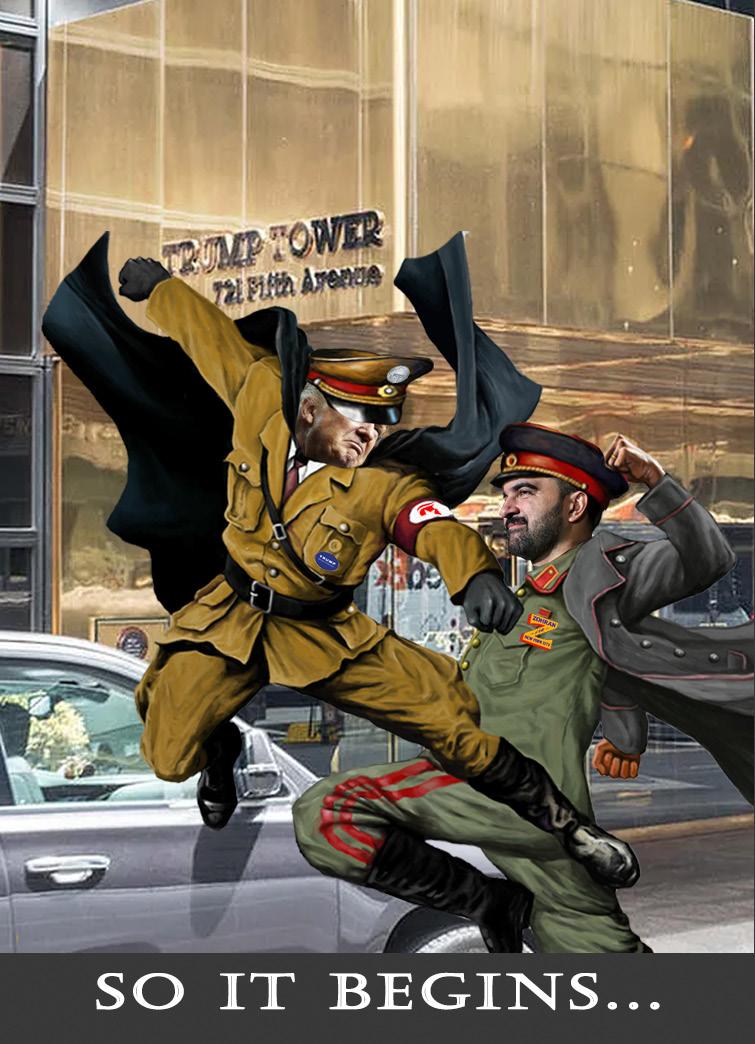

BINGHAMTON REVIEW
From the Editor
Dear Readers,
For the last Binghamton Review magazine of all time, we will be providing you with the best content ever to grace this fine Earth. You may be asking yourself, “Aiden, this is the final magazine ever?” to which I’ll say no. I just wanted to make the final magazine editorial in the big ‘25 sound dramatic. Something for you all to ooh and aww about, but really, we’ve finally made it to the end of the semester. Well, not really, but the university keeps scheduling finals week right up against Thanksgiving, so you’re getting an early one from us. And this magazine isn’t the only thing coming early… because I’m hearing that Santacon is happening on November 22nd! You probably thought I was going to make a sex joke, you goddamn perverts! Instead of Santacon, they should call it Turkeycon… (please clap). So when you’re randomly strolling the big, beautiful streets of downtown Binghamton, keep in mind you might see the worst people you know drunk off their asses with stupid little Santa hats on. And trust me, you don’t want to angrily yank them off their heads (that assault supposedly). ANYWAY, this first snowfall of the year is coming down. So that means it’s time for every student from the city to get behind the wheel of their car for the first time and practice during the bi-weekly Binghamton snow squall. Not like they could drive any worse… And when you’re sitting in the repair shop waiting for the mechanic to fix your car, or are just stuck in your bed because the seasonal depression has fully kicked in, make sure to read this magazine!
This issue has got everything the people want in it: Harvey talk, Christmas movies, construction talk, music review, federal budgeting (if you’re into that), rants, Sodexo praise, pets, and even a review of the Review itself! So folks, there you have it. Our Thanksgiving, Christmas, Hanukkah, Kwanzaa, and Election issue is complete.
Sincerely,

Aiden Miller
Our Mission

Binghamton Review is a non-partisan, student-run news magazine founded in 1987 at Binghamton University. A true liberal arts education expands a student’s horizons and opens one’s mind to a vast array of divergent perspectives. The mark of true maturity is being able to engage with these perspectives rationally while maintaining one’s own convictions. In that spirit, we seek to promote the free and open exchange of ideas and offer alternative viewpoints not normally found on campus. We stand against dogma in all of its forms, both on campus and beyond. We believe in the tenents of free expression and believe all sudents should have a voice on campus to convey their thoughts. Finally, we understand that mutual respect is a necessary component of any prosperous society. We strive to inform, engage with, and perhaps even amuse our readers in carrying out this mission.
Views expressed by writers do not necessarily represent the views of the publication as a whole.
Advice Column
We offered to give you all life advice. Here were your questions:
Has the Kia Soul guy been found yet?
I don’t understand what that girl was talking about. It was NOT AWKWARD!
Why white boys always be wearing short sleeves when it’s cold?
They want their ticket to Agartha
What’s the best beverage to butt-chug this Santacon?
Four Loko!!!!!!!!
Why did Baxter cross Vestal Pkwy?
To not get hit by a car on the way to Texas Roadhouse
Does the Speedway rewards card even fucking work?
Only if you stick up the cashier
Why is FlightReacts a top 0 human of all time?
Isn’t that the guy who popularized that tongue thing? My uncle always does that when my little sister is around. Cool to see a true fan!
How did Cheney die? A heart attack?
He couldn’t live to see a Muslim mayor
When do you think the new lecture hall will be done? I wanna be the first man to dingle my dongle in it
2035. At that point, you’re not just a school beater, you’re a pedo too.
How do I wake up for my Women in Comedy final at 8 AM sharp? I can’t set an alarm cause I just keep sleeping through it
Just show up at 9:55 and hand in an empty test and you’ll be good
What’s happening to beautiful CIW?????
It’s College-in-the-Hood now
You sliming out your hbs or fighting 09 Randy Orton?
09 Orton will punt my head and steal my wife. The hbs getting slimed.
Written by our Staff
What do you think about the wine tasting class? I barely got into it
It sucks! You should drop it now! Please? Can you drop it for me?
Is the spine construction gonna be over any time soon?
You can call the campus Stephen Hawking the way its spine will never work again.
If my baby is hungry and dying, can I get free food from the dining hall?
No can do. It’s our policy.
Some blue-haired shitlib accused me of cultural appropriation. I dressed up as Obama. I’m black. How is this possible????
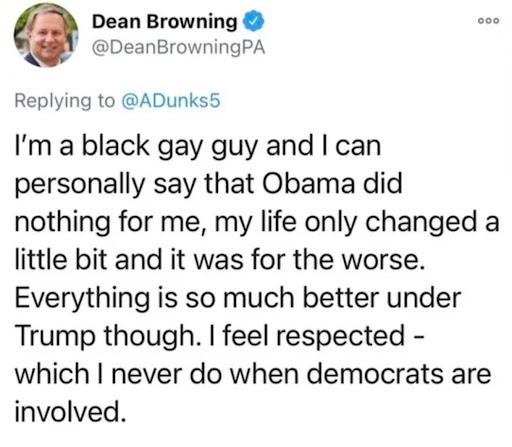
How sensual do you think it gets between J.D. Vance and Erica Kirk? Cause you know they be fuckin
One of them definitely roleplays as a Capitol rioter and the other one as an officer. I just can’t tell which is which.
I’m a cop and I went to go investigate a bomb threat at Pi Lambda, but there was nothing there. What do you think happened?
Bouncer was “cockblocking” a dude from getting no bitches anyway
How can I obtain a Thanksgiving turkey? Not for sexual reasons
Butterball ;)
I’ve been puking nonstop after eating the Simple Servings chicken breast. What do you think I have?
Play stupid games, win stupid prizes.
Need life advice? Email review@binghamtonsa.org for more wacky, quirky, and zany responses.
Pet Collage













The Stenger Report
By Aiden Miller
Well, we’ve finally hit the end of the road. After 13 long months since announcing his departure, filled with much pomp & circumstance, our glorious leader, Harvey G. Stenger, will finally be abdicating his throne. On the 3rd of November, Binghamton’s newly selected president, Anne D’Alleva, will climb the mountain once occupied by Harvey, and as Borat put it, will be the new “King in the castle.” As Harvey’s tenure finally comes to a close, I think it’s important that we take a genuine look at the president’s accomplishments, with only a hint of Binghamton Review sarcasm rather than the usual “milking a dead cow” schtick.

Like many college presidents, Harvey has a complex administrative history, being praised nationally by media outlets and state officials, but often criticized by the student body and Binghamton locals. The position of President of Binghamton University comes with constant flak and pressure associated with being in the spotlight, especially for such a large university dubbed the “#1 Public University in New York.” It’s easy for us at the Review and in the student body to hurl criticism and critiques of the president’s decision. These are often valid, warranted, and protected under the First Amendment, and it would be idiotic to assume Harvey did not realize this was one of the parts of the job.
However, sometimes it’s best to put yourself, oh, I hate how cliché this sounds, “in someone else’s shoes.” Understanding why Harvey and the University made certain decisions can be eye-opening. It reveals how issues which may seem “clear-cut” or “black-and-white”—which are incredibly loaded terms—are far more complex when you’re the one responsible for making those decisions. As I proceed to lay out Harvey’s decisions plainly in the forthcoming section, I believe it’s critical to remember the complexity and difficulty associated with them.
Since becoming president in 2012, Harvey has overseen some major changes at Binghamton University. One of Stenger’s first initiatives was the “Road Map to Premier” plan, hence the constant reminder that Binghamton is “#ThePremierPublicIvy.”
The initiative targeted six key areas where Stenger wanted to see improvements campus-wide: creative activities, learning community, inclusive campus, engagement, strategic investments, and internationalization. This road map was constantly updated to meet the ever-changing needs of students, faculty, and staff, serving as the guiding principles of Harvey’s tenure.
Just to throw some quick stats at you, since the plan’s creation, current student enrollment has increased from 14,746 to 18,850, and full-time faculty numbers jumped from 921 to over 2,800. Research spending rose 70% from around $40 million to nearly $70 million, achieving Carnegie R1 status as one of the top research schools in America. Harvey has also increased the school’s yearly endowment from $55 million to $242 million, enabling the creation of new facilities and the enhancement of academic programs. Graduation rates and retention rates skyrocketed past the national average. And, despite the constant nuisance, Harvey has overseen the construction and renovation of over $600 million to provide for students, faculty, and staff with state-of-the-art facilities for them to live, work, and study in.
Arguably, the most impactful projects under Harvey’s reign were the additions of both the Center for Excellence and Smart Energy Building to the ITC, as well as the creation of the Pharmaceutical Sciences building in downtown Binghamton. Opening in 2014 and 2017 respectively, the CE and SN buildings created a data center laboratory and expanded Harpur College’s Chemistry and Physics departments, enabling research on alternative energy production. In the summer of 2018, the School of Pharmacy and Pharmaceutical Sciences’ $60 million 105,000-square-foot “ultramodern” building officially opened its doors, ushering in a pharmaceutical program that is, as of 2025, one of the top in the nation.
“Harvey Stenger is a man of high moral character, integrity, approachability, and humanity. A man willing to strike up a friendly chat...”
Yet, Harvey’s chef-d’œuvre as President isn’t the construction projects nor the funding increases, but the overall economic impact his policies had on the city of Binghamton and the surrounding communities. Through his initiatives, Harvey Stenger has made Binghamton University the second-largest employer in all of Broome County. Furthermore, in the surrounding area, the University has an annual economic impact of over $1.4 billion. That’s BILLION with a B. This is primarily due to the University’s high local employment and projects such as New Energy New York, which aims to make Upstate New York the country’s leading battery producer.
Now, these amazing accomplishments are not complete without various drawbacks. Increasing the size of the student
body has led to Super Occupancy Housing, where up to four students are packed into a two-person room. Often, these spaces resemble the New York City tenements of the mid-19th century. It’s not quite the Gilded Age, but close. Furthermore, the influx of new students has made class enrollment limited, parking spaces scarce, and overcrowded university spaces such as Bartle, The Union, and East Gym. Moreover, the construction projects undertaken in response to the growth of enrollment have come in rapid succession. Many of the academic buildings and pathways used by students have been closed off for months at the same time. This has made detours and parking issues commonplace on campus in recent months. More consideration should have been given to the planning of these construction projects to ensure that they didn’t all coincide with each other.
However, drawbacks of objectively good policies by Harvey are not the same as the missteps he and his administration have taken at times. Specifically, his handling of the suicide of Natalia Malcevic in October of 2023 raises some eyebrows. As summarized by Arthur O’Sullivan in his incredible article, “What Comes After Tragedy,” the University’s initial response to the suicide was “unprepared” and “unacceptable,” as morning classes proceeded whilst a student lay dead in the center of campus. Furthermore, Stenger’s following statement on the incident, as Arthur put it, “was not skillful” and “threw students and professors alike into confusion.”
The resources offered in the wake of Natalia’s death were incredibly inadequate and fundamentally flawed, but better than nothing. Stenger’s first address to the campus on the day of the incident was filled with compassion, love, and really resonated with students and faculty alike. But his second address to the University was incredibly vague, generic, and overall poor. Harvey would have greatly benefited from a combination of the two addresses into one cohesive and passionate response. Stenger and his administration’s sluggishness to act and vagueness with directives on that day left a profound stain on his tenure. But remember when I said we need to “put ourselves in someone else’s shoes” at the beginning of the article? Well, here’s that moment.

Harvey was, and deservingly so, heavily criticized by many in the wake of Natalia’s death. But despite the missteps of that day, Harvey the man showed incredible humanity, bringing together a grieving campus when they needed it most. And if put in that
situation, I don’t think I or anyone else on campus would have handled the situation any better.

With the way people often speak about Harvey the man and Harvey the president, you’d think the man is the second coming of Satan. Every statement spoken, every letter written, and every action undertaken is scrutinized. We have every right to complain about trivial things on campus, like construction or the Sodexo slop flying out of dining halls. We often have an obligation to speak out on the University’s stances on issues concerning the slaughter of Palestinians, the war in Ukraine, or the lack of mental health resources on campus. These complaints, no matter how small the matter, fall at the feet of President Stenger. Like many great leaders, they sometimes struggle to navigate the treacherous waters of complicated issues, and Harvey has had his fair share.
However, to understand the man and the president, you need to look at the larger picture. Harvey Stenger created one of the top public universities in the country. He has given you, the student, access to the best public education in the Northeast. He has allowed you to enter lucrative careers and follow your dreams. He has allowed you to build friendships and professional relationships you’ll never forget. He has allowed you to live the life you could never imagine.
Beyond campus, Stenger transformed a dying post-industrial city into a city on the rise. He has employed thousands of local residents, cultivating an environment where new businesses open regularly and thrive, making the University the beating heart of Broome County. Without the University, who knows where it would be? I can only hope Anne D’Alleva continues this precedent when she takes the mantle as Binghamton’s eighth president while addressing the issues still present at Binghamton University.
Harvey Stenger is a man of high moral character, integrity, approachability, and humanity. A man willing to strike up a friendly chat while walking around campus on a sunny spring day. A man who commonly attends Fall Fest and Spring Fling. A man who participates in nearly every different type of activity Binghamton has to offer. A man with the unique ability to unite the student body in the face of tragedy. He was never a distant figure like Orwell’s Big Brother; he was just Harvey. It is undeniable that Harvey Stenger was the person for the job— and the person Binghamton needed. And in this house, Harvey Stenger is a hero. End of story!
Eisenhower Warned Us: Federal Funding Paradox Comes Home
By Robert Holahan
Under the current political environment, led by President Trump, we should all take a breath and look at what American History tells us. In particular, President Eisenhower predicted the current University-Presidential conflict in his prophetic speech on the dangers on a Military-Industrial Complex (1960), which is usually condensed to that point. However, he also noted the following:
“… the free university, historically the fountainhead of free ideas and scientific discovery, has experienced a revolution in the conduct of research. Partly because of the huge costs involved, a government contract becomes virtually a substitute for intellectual curiosity. For every old blackboard there are now hundreds of new electronic computers.
The prospect of domination of the nation’s scholars by Federal employment, project allocations, and the power of money is ever present and is gravely to be regarded.
Yet, in holding scientific research and discovery in respect, as we should, we must also be alert to the equal and opposite danger that public policy could itself become the captive of a scientific-technological elite.
It is the task of statesmanship to mold, to balance, and to integrate these and other forces, new and old, within the principles of our democratic system-ever aiming toward the supreme goals of our free society.”
65 Years ago, President Eisenhower foresaw today’s challenges facing Universities. And he was right: At the end of the day, federal funding of Universities comes with strings attached.
Academics hate hearing that funding has strings attached. But it is a fact: Federal funding of Universities is contingent on following federal rules.
For 65+ years Universities have been relatively immune from federal funding stipulations (aside from the slew of liberal-favored stipulations) because there has been a consensus of Americans that Universities are ‘off limits’. But this does not mean that Universities have actually been immune—The threat was always there and it has come home.
The fact is, American Universities have sold their souls to the federal government for money. And now that there is a President who challenges that funding and its purpose, there is a real threat to the existing model of the American University.
What is that model? A top-heavy, Administration-driven model of a University that has completely overtaken the old model of a grass-roots, department driven model that used to dominate. One in which individual faculty made great ideas independent of the latest $5000 research grant from Harpur College. One in which the individual faculty member was the basis of collegiate organization.
Binghamton University has a lot to learn from its past: Our reputation comes entirely from our past as a teaching university that ensured a good education to every undergraduate. Today, our University seeks federal funding like it’s an open faucet, ready to expand every un-profitable and un-employable Master’s Program, because, federal funding will fill the gap regardless of the actual academic value of that Program.
I do not support President Trump, but Universities are on thin ice when they reject federal involvement in their affairs while claiming “academic freedom.” Money doesn’t recognize academic freedom, money recognizes results based on the policy goals of its funder. I don’t know what the future of Binghamton University’s relationship with the federal government will be. But I hope our Administration will recognize that our mission is to serve undergraduate students and provide an exceptional education. Everything else is simply noise.
Robert Holahan Associate Professor, Political Science Binghamton University
Why Home Alone 2 is the Best Christmas Movie
By Bren Dover
Happy
Holidays, reader! With the festive season approaching, many of us will indulge in our favorite Christmas classics, like the live-action How the Grinch Stole Christmas, A Christmas Carol Muppets Edition, and Alvin and the Chipmunks. While we all have our biases, I am here to tell you that they are all mid as fuck compared to the beast of a movie known as Home Alone 2: Lost in New York. This movie is the pinnacle of Christmas movies, embodying the spirit of giving while being absolutely fricking hilarious.
This choice of film might raise some eyebrows. Why the second one, as opposed to the first, considering they have the same plot? How did we settle on this when Die Hard exists? Why are there no Hanukkah movies on this list? First of all, if you can even name a Hanukkah movie, I’ll put it on the list, but until then, there shall unfortunately be no Jewish representation here. Secondly, Kevin McCallister could have easily dealt with the Die Hard terrorists with more ease and whimsy than John McClane ever could. Lastly, the big difference is that the former takes place in shitass Chicago, and the latter takes place in The Big Apple, immediately mogging the first by sheer setting alone. There are, however, many more reasons why Home Alone 2 outranks the original Home Alone and every other Christmas movie, so please read with an open mind.
“Kevin McCallister does indeed have that dawg in him.”
For background information, I was a troubled child. I hated watching movies beyond what I had already viewed. Because of this, I repeated my favorite movies, such as Home Alone 2, over and over until I had a masterful recollection of the entire movie. When pondering why it was so easy to recall each and every line at each and every moment in the film, I realized something. The movie itself works entirely with its soundtrack. Specifically, the soundtrack guides the movie. What this means is that the movie’s music will play in the background, allowing the main lines in the film to fall into tempo with the music. Lines are read on beat and follow the tone of the sound. The entire movie is one big Christmas orchestra, allowing the audience to not only watch an enjoyable film but also take in the music of Christmas. On top of this, some of the most goated Christmas songs are thrown in that perfectly encompass the feeling of every scene, delivering joy, longing, and determination that make them memorable.
Additionally, the movie is a comedy, and comedy it delivers. With witty one-liners and wacky scenarios, it’s truly hilarious. Specifically, there is nothing more fun than violence. I think everyone can agree that it is insanely entertaining watch-
ing a 12-year-old completely shit on two grown burglars and send their asses back to the lobby. Probably the only problem with this movie is how the fuck those guys survived after getting completely dicked by a tween. Kevin McCallister does indeed have that dawg in him, and it is shown by curbstomping not one, not two, not three, but seven grown adults, one of them
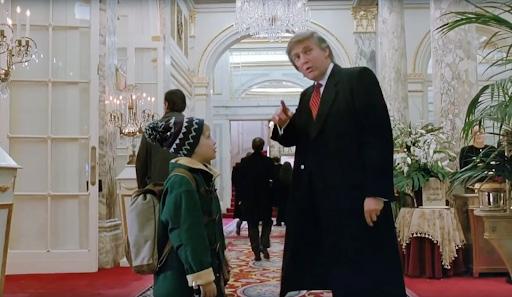
being Tim Curry, by the way. My boy took no prisoners. Then he met the GOAT, pigeon lady, who gave him mad air support and the ability to completely dunk on these hoes, Saddam Hussein style. Mashallah, brother Kevin.
Now let’s talk about the movie’s message. While having more violence than most wars, Home Alone 2 has a lot of heart thrown in. It emphasizes the importance of family, loyalty, and friendship. Kevin’s parents searched all over the city of New York just to find their son. If you do not cry when Kevin and his mom embrace, I think you should be subjected to waterboarding. Additionally, the friendship Kevin makes with the pigeon lady is one of the best on-screen depictions of being able to learn from youth and trusting in your friends. If you have not watched this movie, do it yesterday; it is worth your time. This movie is a masterpiece, and that is indisputable. Fuck your faves. Fuck Charlie Brown, fuck Rudolph, and fuck The Polar Express. Home Alone 2 outranks all of them. I cannot think of another Christmas movie, or even a movie in general, that can deliver a powerful message, bless my ears with a constant symphony, and deliver better kill cam footage than a CoD streamer all at once. Perhaps the first movie can do the same, but honestly, the first movie doesn’t have the Twin Towers in it, and where can you find those nowadays? As for the following Home Alone movies… I have no comment.
This Is What Happens: Bangers of the Human Condition
Have you ever had what was seemingly the perfect life laid out in front of you, only to foolishly let it slip and spend the rest of your life wondering what could have been? The members of jazz rock band The Reign of Kindo sure have. Originating from not-too-far-away-from-here Buffalo, NY, this group of fellas has made many a bop, banger, and jam stretching from the mid ‘00s all the way into the current decade. But what I believe to be Kindo’s magnum opus is their second studio album, This Is What Happens. Released in 2010, the album’s 13 tracks document a wide range of emotions through a wide range of composition styles. I can’t lie; not every song on this album is worth 100 repeats to me, but overall, it’s a jazzy, 55-minute rollercoaster that is absolutely worth listening to.
Firstly, it’s impressive how much each song in This Is What Happens stands out despite belonging to the same genre of jazz rock. They all feature a beat or melody that instantly sticks in your head. This is due to the album’s mastery of basically every instrument, with each track uniting brass, percussion, strings, and piano in a unique way. There is just enough instrumental time to allow the arrangement to shine through without making the songs drag on forever (the longest song is just under six minutes). Structurally, the album experiments with uncommon time signatures and swung rhythms in a few of its songs, and it often blurs the lines between verse, bridge, and chorus. All these qualities of the album give it a beautiful, theatrical sound, reminiscent of a play or musical.

In terms of its lyrics, This Is What Happens can be seen as a concept album about a young man who falls in love, ruins the relationship, and seemingly can never recover. But don’t let the cliché nature of the premise turn you off. The love itself makes up only a small part of the lyrical content, as most of the songs focus on emotions and feelings tangentially related to it. Each song covers a unique human experience, from laziness to nervousness to apathy to despair to acceptance. As such, I can assure even the most asexual of listeners that the album will be relatable.
The album opens with “Thrill of the Fall,” whose opening percussion has you eagerly anticipating what’s about to follow. And then it drops—the deep, 7/8 piano melody that glues the song together. We’re then given a detailed account of the protagonist’s
By Angelo DiTocco
uneasiness about what lies ahead, accompanied by the iconic imagery of a long, rickety bridge shaking in the wind. Yeah, it can snap in two at any moment, but that’s what makes life interesting, isn’t it? The piano and guitar accentuate the vocals perfectly as the analogy continues, culminating in an epic climax as it ends.
Three songs later is the chaotic yet beautiful piece that is “Bullets in the Air.” This one perfectly alternates between noisy instrumentals and calm but uneasy melodies as the singer warns against crashing out at others. It’s truly an anti-Machiavellian take on interpersonal connections. Descriptions of your friends complimenting you to your face and cursing you out behind your back is followed briefly by one of the most incredible piano riffs of all time. The opening warning is then given one last time in case you weren’t humbled enough.
Further on in the album is “Out of Sight, Out of Mind,” a song about putting the rest of the world, well, out of sight and out of mind. I’m sure this is something we’ve all been through—lost and not feeling it, sometimes you just gotta lay low and go through the motions. The piano complements the vocals perfectly on this one as well, with the brass and guitar picking up the slack in the instrumental sections. The last note fades out just as you’re submitting the poorly-written article you promised for the Halloween issue but didn’t have enough time to write thoroughly. Or maybe that’s just me.
Immediately after is “Comfort in the Orchestration,” which is thematically one of my favorites. This one is heavier on the piano and the drums, and it tells the story of a director who can’t control the actors in his play no matter how hard he tries. This is such an interesting perspective on life that I’ve practically written a whole ‘nother article about it. In my undergraduate reflection piece, “The Unscriptable World,” I detail how this song has helped me come to terms with all the failed attempts I’ve made to steer my life in a certain direction. It’s often much simpler and healthier to live in the moment and deal with whatever comes your way.
I’ll end this review with the last song of the album, “Psalm.” As you can guess by the title, this one has a double meaning, providing a unique intersection between romantic and religious frustrations. Here, the protagonist is overwhelmed and defeated, losing touch with reality as he begs for help from an uncaring God (or ex) who has all but forgotten about him. This is all supplemented by a full yet structured arrangement of piano, drums, brass, and even choir vocals. I’m not religious in the slightest, nor do I have an ex, and even to me, this song conveys such raw levels of emotion that are hard to find elsewhere. If you’re gonna listen to one song from this album, I’d pick either this one or “Thrill of the Fall,” depending on your current mood.
No matter how you’re feeling, The Reign of Kindo’s This Is What Happens has a song for you, or maybe even multiple. As such, I can’t suggest an optimal time or place to listen to it. The only thing I can say with confidence is that it will be a jam to the ears and the mind alike.
Binghamton Bar Rant
By Horatio Sterling
The great Binghamton Nobel laureate Sir Michael Stanley Whittingham once said, “To be a successful student at Binghamton University, a student needs to do one of two things: complete a doctorate in electrical engineering or adamantly defend their favorite bar in downtown Binghamton.” Now, if you’re stuck reading the Binghamton Review, you’ve probably only done the latter. And hey, hands up, I’m in the same boat as you.
Once you reach “unc” status like myself, the ebb and flow of which bars are hot and which are not becomes evident. So, for a quick anecdote: during my freshman year here at the Premier Public Ivy, the Rat was the place to be. As a young, innocent freshman, I vividly remember the Rat winning SUNY Barstool’s “Best College Bars in New York” tournament. When you went there on a Friday night, the line wrapped around the block. By sophomore and junior year, if you weren’t playing Feud at Tom’s, then you might as well have been missing out on the chance to meet Steve Harvey himself. Now, as the resident senior at Binghamton University, The Grove and Red Jug have taken the mantle as the “places to be.”
In my eyes, there are two things this city is known for: bars

and academics. Many of us come for the academics but stay for the bars. When you finally make your way up to Binghamton, either as an ignorant college freshman or a friend staying the weekend, you’ll ultimately find yourself in the conundrum of deciding which bar to wet your whistle at. Some will say Tom’s, others will say the Jug, some in the very back will say the Rat, but nobody ever knows. On many nights, you might as well call your friend group Congress, the way they can’t come to a resolution on a spending bill (the bar tab). So, in a last-ditch effort to reach consensus, you open up your cellular device and scroll the ‘gram, looking for where “the people are at.” That’s when you see it: Binghamton bar propaganda.
Binghamton’s bar propaganda is a campaign not seen since the likes of Mao. Bars and students alike relentlessly push out statements like “The Grove is the place to be,” “Tom’s is where it’s at,” “My friend Jerry just got mugged and creampied at the Rat,” and so on. Try to find a difference in the images:
Whether it’s Mao-esque or something more similar to our lord and savior Zohran in the city, bars and their fans have consistently and vehemently pushed out propaganda to increase customers. Currently, word of mouth and reports of “new” and “exciting” bar “innovations” have been used to increase traffic


to certain bars downtown. For example, Red Jug recently introduced their partnership with a line-cutting app where bar-goers pay to skip the wait. Meanwhile, The Grove recently announced the addition of a third floor where students can party to their hearts’ content. I know what you’re thinking: “Should people be allowed to pay to cut in front of me in line?” and “Does a bar really need a third floor?” The answer to these questions is fuck no. Get in line like the rest of us and suck it up, buttercup. Also, a bar with a balcony is basically asking for someone to fall off it…
If that wasn’t enough to get the hairs on your neck to stand up, YikYakers of all ages have been spending their nights either praising these shitty “innovations” or just throwing tantrums about their “bad” experiences at certain bars. In most cases, these tantrums usually stem from drunk white girls having a little too much Pink Whitney, ultimately resulting in them throwing up on the sidewalk. The night ends as they look up at the sky, fist in the air, saying something like “[insert bar] will rue the night they kicked me out for getting #whitegirlwasted.” Yes, woman on YikYak, we know you had too much to drink and have strong feelings about it.
So at this point, you’re probably wondering what the fuck the point of this article is. Well, the point is to say this: Go to whatever bar makes you happy. Screw the propaganda and the shitbags who tell you where you’re allowed to have fun. Have that espresso martini! Turn that Creed up on TouchTunes! And please stop using YikYak or Instagram comments sections as the ultimate decider on where you’ll be going to get plastered for the night. As long as the bar has cheap drinks and music, that’s the place to be.

P.S. If you use YikYak, I’m coming for you…
Geopolitics Have Hit the Eastern Caribbean
Life in the Eastern Caribbean has been relatively peaceful in terms of broader geopolitics for quite some time, having reached its peak with the fall of Grenada’s socialist New Jewel Movement in 1983 (a tale for another article). Even in online infographic maps that display various metrics, the region is rarely ever visible. Seriously, when was the last time you looked at a world map infographic and were able to perceive any nation of the archipelago below Puerto Rico?
To get back on topic, the regional pepper pot, as it were, is currently being stirred with unprecedented vigor, with Venezuela making some moves. Venezuela was one of the top, most thriving economies in the Western Hemisphere in the late 70s, but as socialism took hold and was continued under the current president, Nicolás Maduro, things turned for the worse. As of 2025, Venezuela suffers from some of the worst inflation and poverty in the hemisphere. Perhaps current actions are a bid to fix things at the expense of every neighbor possible.
Currently, Venezuela is making a name for itself as a new regional bully. From ongoing border disputes with Guyana over the Essequibo region (a little over half of Guyana’s land) to encroaching on its offshore oil fields with gunboats, Venezuela is shouldering its weight against a country with significant ties to the Eastern Caribbean. With its predominantly English-speaking, Afro-Caribbean and Indo-Caribbean population, Guyana is widely regarded as part of the Caribbean, despite its geographical location in continental South America.
These ties bring another country neighboring Venezuela into hot water: Trinidad and Tobago (T&T), arguably the cultural capital of the region. Unlike many of its agriculture and tourism-centered island neighbors, T&T is an energy- and industry-based economy. With 40% of its revenue from energy, it is historically one of the largest suppliers of Liquefied Natural Gas in the Western Hemisphere. As its gas production has declined recently, T&T is eyeing the Dragon gas field, located just past the maritime border with Venezuela, to keep the flare stack burning, which was to be a joint effort between the two nations.
Late last month, the US Treasury permitted T&T to work with Shell Oil to begin extracting oil from the field, marking the first step in ensuring the country’s economy stays afloat while further securing the region’s energy resilience. Recently re-elected Prime Minister Kamla Persad-Bissessar is an avid supporter of United States President Donald Trump, at least for his views on drugs and crime in the region. This support has drawn the ire of Maduro, leading Venezuela to declare Persad a persona non grata and suspend existing energy-development cooperations, endangering T&T’s plans for the Dragon field. Nevertheless, Persad is more than willing to cooperate with Trump’s campaign against Venezuelan drug boats, supporting US military presence in the Gulf of Paria that separates the neighbors. This comes even after the deaths of two innocent
By Liam Steele
Trinidadian fishermen at the hands of a US missile strike that read them as cartel thugs.
As a Grenadian, I feel connected to my southern neighbor and its struggle with crime and gang activity, bearing the mark of eight times more murders per million people than the US. Still, I can’t help but feel trepidation regarding all this, as Mrs. Persad is known for this colorful quote from her reelection campaign this year:
“Don’t let this happen to your family. You vote for the UNC, and we will give you stand your ground laws, home invasion laws and legal firearms. And when these brutal rapists and violent criminals attempt to invade your homes, you load up your matic, light them up, empty the whole clip. And when you done knock it on them, knock it again, then call meh name, Kamla…”
At its core, the quote is about taking action against the country’s plagues. But the hotheaded and rash nature of it all reflects poorly on other CARICOM (Broader Caribbean Community) members’ trust of her handling of the US partnership. However, it should be said that T&T’s proximity to the issue certainly does afford them some authority on the matter over more distant islands. The new “war on drugs,” as it is being known, feels more like merely a facetious name for Trump’s operation to remove Maduro from power, with bribes being given to Maduro’s pilot to cooperate in a US plot to detain him. Maduro is likely to be not just complacent but actively involved in his country’s involvement in the drug trade, allegedly being part of the “cartel of the suns.” Trump’s assertion that Venezuela plays a role in the fentanyl crisis specifically is fickle at best, weakening his push for involvement, but what is true is that the country is a part of a route for cocaine, at least. Whatever the operation is, the muddy mire of involvement in it is working its way up the chain of islands, with the US seeking to install temporary radar installations and technical personnel at Grenada’s airport.
As we gear up for this decade’s basically mandatory violation of international law by the USA, we can only hope it ends favorably: Venezuela under better leadership with a secure economy and future, drugs not reaching everyone’s shores, and its hands out of everyone else’s business.
So much ‘happening’ is happening in my region so fast, and not long after my country had finally elected a new prime minister who does actual good for the country after flipping between the same two bums for a total of 26 years. In 2017, Grenada discovered its own oil field, and where else but—you guessed it—the maritime border with Venezuela. Trinidad has stepped up to assist with its development. Still, somehow, I can’t help but feel a bit on edge about how this might drag us into more happening.
Natural Disturbances
By Brøm Bremnergaard
The world reeks of dread. There is nothing more formidable than the presence of other people: those who have lost their sense of spatial awareness, those who ride their e-scooters into the nothingness of life, and those who cause construction. Oh, that construction… how it kills.
It was the time before the coming of daylight savings, when the sun still set at a reasonable hour. My roommates and I were strolling towards the dining hall, and I decided to gaze into the yellow sky. The sun beams that were still high enough in the sky to bypass the hills illuminated every particle in the air… including the bugs. It was truly a disgusting sight juxtaposed against the beauty of a sunset. It was horrible; the surrounding air was dense. Gnats were flying in my hair and eyes, swarming the Mountainview soccer players, and terrorizing any soul that walked unbeknownst into the eighth plague of Egypt.
I was in awe, really, at least when I wasn’t focused on defending my own personal space. On this day, I had to protect my own dinner against these fuckers. As I profusely swatted with my hand to protect my rarely offered 4-cheese Binghamton Mac n’ Cheese, I finally expressed, “These fuckass bugs! It’s October! Shouldn’t they be gone by now?!”
One of my roommates responded (squinting her eyes), “It’s the construction.”
“The what?”
“The construction by College-in-the-Woods, where they’re building the new dorm.”
For those who are completely unaware of the (yet another) construction project between CIW and Mountainview, they have torn down all the trees between the colleges to make room for “record admissions”. All of those “preserved” trees are gone, torn up, and terraformed.
The gnats were bugs that lived in the ground. Why? I don’t know, they just do. They like to live out their lengthy (one-week) lives in the mushy soil. They once resided in the same area now occupied by woodchippers and those big digging things (I can’t be bothered to actually look up the name for them). Since their home was uprooted, they needed to find refuge elsewhere. Where else is a better place to migrate to than the vast community that is Mountainview?

Binghamton accepts more and more students (more of these wretched freshmen) and has no choice but to build yet another dorm hall. An addition to Mountainview, they say. The horns of trucks and the gnawing of woodchippers haunt the surrounding people. On one such day, amidst the sea of melancholy, I found myself sauntering along the CIW soccer field and contemplating my upcoming existential crisis. Suddenly, I heard this agitating, grating noise. A growling chainsaw was tearing apart one of the many trees to make space for the new project—my God!
I look over just in time to watch a tall tree—one that has perchance been around for decades—gracefully fall towards the ground. It was a soft fall, ironically; its branches broke the impact, causing a muffled crash. My eyes were locked onto the poor thing, and I was suddenly struck with a strong sense of dread—a realization, really, of the impacts of the increasing size of SUNY Binghamton. The green wave will inevitably swallow us whole.

A couple of days later, I was carrying my new package up the CIW hill, and I caught a glimpse of movement in my peripheral vision – a snake. I took note of its yellow belly and dark gray top and identified it as a garter snake. It was particularly large, but not remarkable. It slithered with a reasonable speed and retreated after every one of my sudden movements. Snakes love the natural heat lamp in the sky during the summer months, but this little creature missed the memo and stayed out late. But it wasn’t the snake’s fault; it never was. The darkness of this world is responsible. The snakes, among all the other animals in that area, fell to the same fate as the gnats. They usually find shelter underground during the winter to keep warm, but their burrow no longer exists.
While the construction on the main campus is more of an inconvenience (it’s just ripping up tiles and replacing them), the project of building a new residence hall is genuinely harming the environment around it. Trees are being cut, animals are being displaced, and it is disrupting the lives of the students around it. Binghamton is accepting more students than it should, but what else can we do?
How Dining Hall Workers are Compensated
With numerous health code violations at dining locations operated by Sodexo, there have been concerns about whether Binghamton University will renew its contract with Sodexo this year. Since its contract began in 2014, there have been several unionization efforts from the United Professional and Service Employees Union in order to increase the salary for its employees.
Here is how the salaries of Sodexo workers look in context compared to those in the city of Binghamton overall.
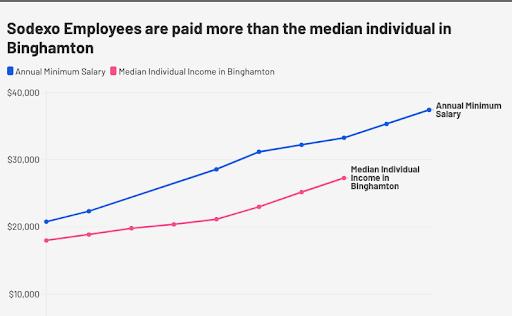
When compared to Binghamton’s broader economic landscape, Sodexo workers fare better than many of the city’s residents. The city’s median individual income has risen from $18,000 in 2016 to an estimated figure in the mid-to-high $20,000s in recent years, meaning Sodexo’s minimum salary substantially exceeds what most Binghamton workers earn. However, do keep in mind that both of these numbers are comparable to the poverty wage of $26,644.80 for a family with one working parent and one child.
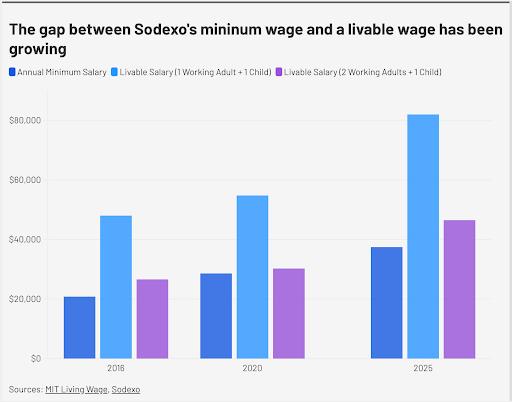
By Xinpeng Gao
$37,440, based on working 2,080 hours per year (40 hours per week for all 52 weeks). While this marks an 80% increase since the contract began in 2016, when workers earned just $20,800 annually, it still falls dramatically short of the living wage needed for families with one or both working parents in the region: $81,994 and $46,488, respectively. These figures come from the MIT Living Wage calculator, which estimates the living wage using expenses such as housing, food, healthcare, etc.
At Binghamton University, most non-faculty staff belong to the Civil Service Employees Association (CSEA), which negotiates salary schedules with New York State. Comparing Sodexo’s minimum salaries with these employees offers more context. NYS civil service employees are categorized into salary grades —from Grade 1 to Grade to 23 —with Grade 5 (G5) and Grade 7 (G7) representing entry-level to moderately experienced positions across various state agencies. G5 positions typically include roles such as routine cleaning, trades, office assistant positions and other clerical support staff jobs requiring minimal prior experience. G7 positions represent a step up, including roles such as janitorial jobs and semi-skilled maintenance duties including minor repairs to fixtures, using power tools, and assisting with light carpentry, plumbing, or electrical work.
In 2025, the hiring rate for G5 positions is $34,312, while G7 positions start at $38,235. Sodexo’s minimum salary of $37,440 now exceeds the G5 rate by 9% but remains slightly below the G7 benchmark. However, this is only a recent development—until 2021, Sodexo workers earned less than even G5 state employees, despite working in food service roles that require food safety certification and often involve physically demanding labor.
Still, Sodexo does provide some employee benefits such as free food, having flexibility to choose their shifts, and a good health “coverage system” according to Glassdoor Reviews from past employees, culminating in a 4.0/5 rating there, with 60% of people recommending working at Sodexo to a friend. However, they also mention that the work can get “repetitive at times” and the pay could be more competitive. Multiple reviews also mentioned the presence of “terrible supervisors,” resulting in severe mismanagement.
Overall, low wages can contribute to high turnover, which can affect knowledge about food safety protocols and overall operational quality. Whether the university views these issues as being connected to the recent health code violation remains unclear as contract renewal discussions continue. While recent gains bring starting salaries closer to meeting living wage benchmarks for some families, significant gaps remain, particularly for single-parent households. The university should consider the well-being of employees in its dining hall in addition to the quality of its services.
The 2025 minimum salary for Sodexo workers starts at
“Accurate” Review Of Binghamton Review
As a student residing at this University, there are many activities you can partake in during the dark hours of the night, such as Late Nite, movie nights, or smoking weed in your dorm in Cayuga and setting off the fire alarm for the fifth time. But what I found myself doing on a particular Wednesday night was picking up a magazine with a god-forsaken cover and reading its content front to back. The funny words amused me, so I decided to do some research on this “Binghamton Review” to see if everything was as humorous as the one I picked up that day. So, this is my review of Binghamton Review.
To begin this review, we must first analyze the individuals who create these masterpieces. We’ll begin with the Editor-In-Chief, Aiden Miller… and that covers it, since I can’t find any information about him online other than this baseball player and this X account, which I refuse to go into because I’m afraid of opinions that rival mine. But in all seriousness, Aiden Miller does write in the front of Binghamton Review for every published issue, so I won’t slime him out. Rating a person feels wrong, but so does racism, and people still do that anyway. With that being said, I’m giving Aiden Miller a succulent [27 good opinions out of 0 bad opinions].

Next, we have Copy Desk Editor Angelo DiTocco, the only one brave enough to post multiple articles onto the website stating the most diabolical claims that a person can conjure up, such as “Halloween Is Mid” or “I’m Dropping Out,” and then proceeds to, in fact, not do that. Unlike the other staff members, Angelo DiTocco seems to be the most proud of what he does with Binghamton Review, as he cannot stop posting articles in every issue. It was actually his article on October 29th that pushed me to write this article. “Halloween is Mid” Angelo claimed right before shitting on everything about Halloween that an average sorority girl would go bat shit crazy over. Which
By Dave Lin
means that anything he says is automatically valid until my Visa expires. So I’m giving Angelo DiTocco [12 expired visas out of 12].

But enough of the “people” who write these articles. Let’s talk about the articles themselves and WHY they’re masterpieces, as well as discussing why the staff totally deserves to get paid (in monopoly money). My first experience entering their website was unexpected, for such unprofessional articles, the website was actually well-crafted. The words “Binghamton Review” are inscribed on the top of the page in the largest, UGLIEST font ever fabricated by man. Each article has certain tags that represent the content that resides in it, such as Politics, Campus, Arts & Media, Humor, and Web Exclusive. The tags are very diverse, unlike this university, and are all filled to the brim with content. The website would continue to impress me with its layout, displaying featured articles on the front of the page and a slider that shows the reader the latest articles. To conclude, the website is phenomenal, minus the poopoo caca font on the top of the page. I would give the website a generous rating of [67 code grey patients out of 69.]
Other than the website, what really caught my eye was the physical magazine these “people” shamelessly showed to the world. The content stays the same, but it’s the extras that exist in these magazines that truly make Binghamton Review such an experience. The “Advice Column”, a section where the staff of Binghamton Review tries to kill off as many students as they can with terrible advice. The Editorial, where the Editor-In-Chief gives the reader a synopsis of the magazine.
Binghamton Review is probably the most joy I’ve gotten out of reading in a while, so if you’re reading this, go pick up another one. In conclusion, I give Binghamton Review a solid [0 parking spaces out of 0].
Thank you. I love you, reader. Say it back. Say it back, please. Please?
